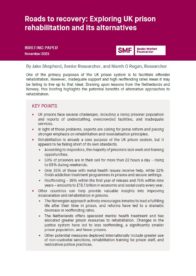One of the primary purposes of the UK prison system is to facilitate offender rehabilitation. However, inadequate support and high reoffending rates mean it may be failing to live up to that ideal. Drawing upon lessons from the Netherlands and Norway, this briefing highlights the potential benefits of alternative approaches to rehabilitation.
KEY POINTS
- UK prisons face several challenges, including a rising prisoner population and reports of understaffing, overcrowded facilities, and inadequate services.
- In light of these problems, experts are calling for penal reform and placing stronger emphasis on rehabilitation and resocialisation principles.
- Rehabilitation is already a core purpose of the UK prison system, but it appears to be falling short of its own standards.
- According to inspectors, the majority of prisoners lack work and training opportunities.
- 53% of prisoners are in their cell for more than 22 hours a day – rising to 69% during weekends.
- Only 35 % of those with metal health issues receive help, while 32% finish addiction treatment programmes in prisons and secure settings.
- Reoffending – 39% within the first year of release and 75% within nine years – amounts to £18.1 billion in economic and social costs every year.
- Other countries can help provide valuable insights into improving incarceration and rehabilitation in prisons.
- The Norwegian approach actively encourages inmates to lead a fulfilling life after their time in prison, and reforms have led to a dramatic decrease in reoffending rates.
- The Netherlands offers specialist mental health treatment and has allocated greater prison resources to rehabilitation. Changes in the justice system have led to less reoffending, a significantly smaller prison population, and fewer prisons.
- Other potential measures deployed internationally include greater use of non-custodial sanctions, rehabilitation training for prison staff, and restorative justice practices.

DOWNLOAD THE BRIEFING: PDF
